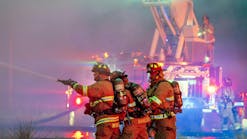From Awareness to Action: Bridging the Gap to Reduce Firefighter Line-of-Duty Deaths
The dangers and risks associated with firefighting have been recognized for generations, yet line-of-duty deaths (LODDs) continue to claim the lives of brave individuals who dedicate themselves to serving others. While the fire service has extensively studied and identified the leading causes of LODDs—sudden cardiac events, trauma, and cancer—a significant challenge remains in translating this knowledge into effective preventive actions. To truly protect our firefighters, we must move beyond merely understanding these dangers and focus on implementing proactive, impactful measures. By addressing these issues with urgency and commitment, we can create a safer environment for those who put their lives on the line every day.
Understanding and addressing firefighter fatalities
The leading causes of firefighter LODDs are well-documented. According to 2023 data from the National Fallen Firefighters Foundation (NFFF), sudden cardiac events remain the most frequent cause, accounting for nearly half of all LODDs. The intense physical and mental demands of firefighting, paired with extreme exertion, place significant stress on the cardiovascular system, particularly for those with preexisting risk factors or inadequate fitness levels. As Dr. Michael J. Karter, a leading expert on firefighter health, has observed, "Firefighters face multiple, intertwined risks every day—cardiac events, trauma, and cancer—and each of these factors requires specific, proactive measures to mitigate their impact." (Karter, M.J., "The Health Risks of Firefighting: A Comprehensive Review," Journal of Occupational Safety, 2023)
While fire service leaders have long understood all the associated risks in firefighting and access to extensive research in the primary causes of LODDs, the challenge lies in applying this knowledge to effectively prevent future fatalities. The NFFF has been at the forefront of promoting initiatives aimed at improving safety and reducing LODDs, but progress requires a better collective response from departments and leaders across the country. Bridging the gap between awareness and action is essential for firefighter safety, and moving forward, the fire service must concentrate on implementing practical, actionable strategies that prioritize prevention, health, and resilience to ensure the long-term well-being of our personnel.
Where we are falling short
Despite this high level of causation awareness, the collective fire service continues to be slow in adopting key safety practices that could possibly prevent many of these deaths. Research has shown that sudden cardiac events can often be mitigated by maintaining better fitness standards, but many departments lack consistent physical wellness programs. In some cases, there’s even resistance to instituting rigorous fitness regimens or providing enough support for wellness initiatives.
Cancer continues to take a toll on firefighters across the nation, yet prevention efforts are still inconsistent. Many departments are adopting newer decontamination practices, but they are not always being enforced or integrated into daily routines. Outdated or soiled gear that does not adequately protect against carcinogens remains in use in some areas, and there is often a lack of awareness about the risks posed by toxic exposures. Additionally, a comprehensive approach to cancer prevention, including regular gear inspections and mandatory decontamination protocols, is still not universally implemented, leaving firefighters vulnerable to long-term health consequences. As Dr. Jeff Burgess, a prominent researcher in firefighter health and safety, has emphasized, “Firefighters are exposed to toxic chemicals on a daily basis, and without proper decontamination and protective measures, the long-term health consequences can be devastating.” (Burgess, J., "The Impact of Cancer on Firefighters," Firefighter Safety Journal, 2022)
And lastly, we are beginning to better understand how critical decision-making plays a pivotal role in ensuring firefighter safety, especially in high-stress emergency situations. For less experienced officers, the ability to make quick, informed decisions can mean the difference between life and death. However, many new officers are not receiving the comprehensive, scenario-based training they need to prepare for the unpredictable nature of these events. It is essential that fire departments invest in enhanced leadership training programs that focus not only on technical skills but also on developing judgment, communication, and crisis management abilities.
Moving from awareness to action
The good news is that we already have the research, technology, and tools to make a significant impact on firefighter safety. Wellness and fitness programs are designed especially for firefighters to lower the risk of cardiac events, and we know how to implement them effectively. New PPE can better protect firefighters from toxic substances, and innovative cancer prevention strategies, such as enhanced decontamination protocols and gear replacement programs, are making a difference.
In addition, the fire service has also recognized the importance of mental health support. Stress management and addressing the psychological toll of the job can help improve overall health and reduce the physical consequences that lead to injuries and fatalities. Through their affiliate organization, The First Responder Center of Excellence, the NFFF continues to be pivotal in providing resources for firefighter mental health, but it is still up to individual departments to integrate these practices into their cultures and make mental health support a priority. As Dr. David L. Thomas, a leading psychologist specializing in first responder mental health, has stated, “We cannot ignore the mental health of our firefighters. Providing access to care and fostering a supportive environment is crucial to their overall well-being.” (Thomas, D.L., "Mental Health in First Responders," Journal of Firefighter Wellness, 2022)
Moreover, to truly create lasting change, it is essential for fire service leaders to foster a culture that prioritizes safety and well-being across all levels. Fire service leadership carries the responsibility of setting the tone for safety practices, allocating resources, and ensuring that policies are not just implemented but embraced by all members. This means not only employing the available tools and strategies but also ensuring that every firefighter understands the importance of prevention and is supported both physically and mentally. Leaders must also advocate for continuous education and provide the necessary training to make safety a core part of the fire service culture.
Actions leaders can take
Fire service departments can take several real, actionable steps to reduce injuries, illnesses, and LODDs without significant hardship or financial investment. Many of these actions are relatively low-cost and can be implemented quickly, leading to immediate improvements in firefighter safety and well-being. By focusing on health, safety protocols, and continuous learning, leaders can make a tangible difference in protecting their personnel.
- Prioritize Health and Wellness Programs
Leaders must prioritize the establishment and promotion of comprehensive health and wellness programs tailored to the unique demands of firefighting. This includes annual physical exams, fitness assessments, and mental health resources. Working with local trainers or fitness experts to create a program that fits the specific needs of firefighters can further enhance these efforts. Encouraging a culture of fitness and regular health monitoring helps identify and mitigate risks such as cardiovascular disease and stress-related illnesses before they become critical. - Implement and Enforce Safety Protocols
Establishing clear, evidence-based safety procedures and ensuring compliance is essential. Regular training on standard operating procedures (SOPs) for fireground operations, vehicle safety, and PPE usage is vital. Collaborating with other departments to share best practices and improve safety protocols can also enhance overall effectiveness. Leaders should also encourage personnel to prioritize safety by fostering a mindset where taking necessary precautions, even if it means altering tactics, is always the right choice to ensure long-term health and safety. - Invest in Cancer Prevention Measures
Given the ever-rising risk of occupational cancer, leaders must enforce measures that reduce exposure to carcinogens. This includes mandating proper decontamination of gear and equipment, providing second sets of PPE if possible, ensuring clean living and workspaces, and educating firefighters about the importance of personal hygiene post-incident. Additionally, leaders must emphasize the critical importance of wearing PPE properly while in toxic environments to minimize the risk of exposure to harmful substances. Working with local healthcare providers to offer screenings and early detection programs can further support efforts to identify cancer risks early and protect the long-term health of firefighters. - Foster a Culture of Continuous Learning
Leaders should embrace training and education as ongoing priorities, not occasional events. This involves implementing regular, scenario-based training to reinforce safety practices, critical decision-making skills, and keeping the team updated on emerging threats and prevention strategies. Submitting for grant funds or working with local sponsors to send personnel to national safety conferences and taking advantage of free training opportunities, such as those created by the NFFF, can also broaden understanding of best practices and ensure that departments stay at the forefront of safety advancements.
Time to act
We stand at a critical juncture, where the fire service community and leadership possess the knowledge and tools necessary to prevent many of our firefighter fatalities. The time for inaction or claiming ignorance has passed. Failing to take proactive steps now undermines our efforts to prevent LODDs that we continue to work so hard to prevent. These resources hold significant potential, but their true impact can only be realized when they are applied consistently and effectively.
The need for immediate action is critical and cannot be overstated. Waiting for another injury, illness, or LODD to drive change is no longer acceptable. Fire service leaders must prioritize swift and comprehensive improvements in health, wellness, and operational practices. Change must happen today, not tomorrow, to protect our firefighters to the best of our abilities because it is our responsibility to ensure that every firefighter has the best chance of coming home safely after every call or shift.
This must start with leadership—fire chiefs and officers creating a culture where safety is not just a priority but an expectation and a way of life. Turning awareness into action is not just a goal, it is a commitment we must fulfill with urgency, foresight, and common sense. By implementing a few proven strategies and weaving them into the fabric of daily operations, we can not only reduce firefighter LODDs but also build a legacy of safety for the next generation of firefighters.

Gary Krichbaum
Gary Krichbaum is a retired assistant fire chief with the Prince George’s County, MD, Fire/EMS Department. He is the program manager for the First Responder Center for Excellence. Krichbaum also is the Maryland Director of the Eastern Division of the International Association of Fire Chiefs. He holds a Master of Arts in Emergency and Disaster Management and a Bachelor of Science in Fire Science.







